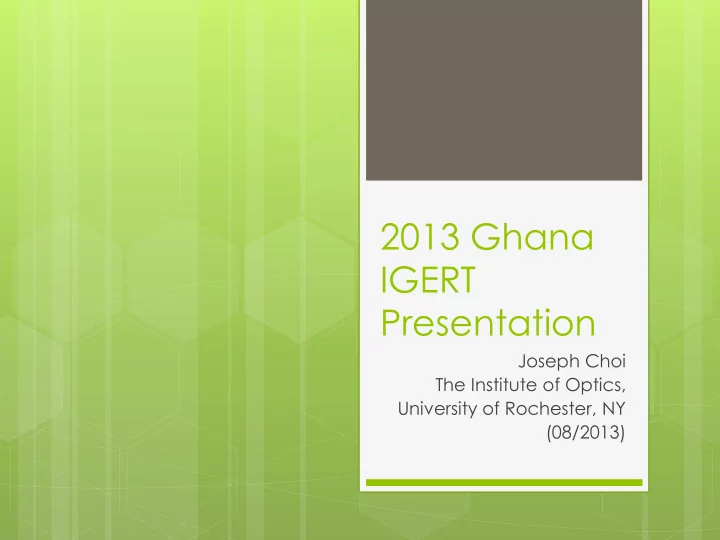

2013 Ghana IGERT Presentation Joseph Choi The Institute of Optics, University of Rochester, NY (08/2013)
Part I: Background Optical Activity and Chirality
Optical Activity Due to Chirality- Mirror Images not superimposable. Significance : 3D information of molecules Drugs can be poison if wrong `handedness’ Possible engineering of efficient solar energy cells 1-5 1. http://www.ecs.soton.ac.uk/news/679 2. http://hdl.handle.net/2142/42174 3. Sabah, Uckun, J. Optoelectronics and Adv. Mat., Vol. 8, No. 5, pp.1918-1924, 2006. 4. Srivastava, et al., Science , 2010; 327 (5971): 1355. 5. Iowa Energy Center
Light = Electric Magnetic (EM) Field Linear Polarization ( LP ) Left-Circular Polarization ( LCP ) 1. 2. Right-Circular Polarization ( RCP ) 3. Left-handed or Right- handed molecules interact differently with LCP and RCP light
Optical Rotation (ORD) Rotation of Linearly Polarized light Because: Linear Polarization = LCP + RCP 1. Left- and Right-Circular 2. Polarized light rotate differently in chiral molecules
Circular Dichroism ( CD ) Absorption different for LCP and RCP in chiral medium Circular Dichroism = This Differential Absorption
Measuring Optical Activity Differential signals for left- vs. right-handed fields and molecules: Very small (10 -6 – 10 -3 ) Difficult One measure is Dissymmetry Factor: 𝑩 𝑴 − 𝑩 𝑺 ( 𝑩 𝑴 + 𝑩 𝑺 )/2 ~ Circular Dichroism 𝐡 = Average Absorption where A L = LCP Absorption Rate, etc.
Part II: Limitations of a Superchiral Field Choi, J. S. and Cho, M. Physical Review A 86 ,063834 (2012)
“ Superchiral ” Light Can we enhance Optical Activity signals dramatically? Y. Tang and A. E. Cohen, Science 332 , 333 (2011): Engineer light to increase Chirality (Not to scale) (Sample size relative to field ~ to Create Standing Wave of scale) Partial z =0 Mirror RCPL + LCPL with mirror ( SWCF ) SWCF CPL Place Chiral sample at Electric Field Energy ( U e ) Minimum (node) Sample z 1 Layer
Cohen’s “Superchirality” - Results Enhancement: g 𝑑 𝐷 → 1 + 𝑆 = g CPL 2 𝜕 𝑉 𝑓 1 − 𝑆 R = Reflectivity of mirror • “ Optical Chirality ”: • 𝐷 ≡ 𝜗 0 2 𝐅 ⋅ 𝛂 × 𝐅 + 1 𝐂 ⋅ 𝛂 × 𝐂 2𝜈 0 For R=0.72: 11x enhancement For R=1: Infinite enhancement?
WARNING- MATH FUN! Induced electric (p) and magnetic (m) dipole moments: Work done by EM fields: Total absorption rate of molecules:
Generalized g for SWCF- Final Combined 𝐷 , 𝑉 𝛿 Calibrated amplitudes (R) Substituted with averaged parameters
g 0 for SWCF when Δ n=0 (Simpler formula, good approximation) Drop 𝛿 0 (10 -6 -10 -4 )? No, or else same as Tang and Cohen. Write denominator differently -> U e min => U b max.
Correcting Dissymmetry Factor (g) Conservation of Energy: Electric Energy( U e ) + Magnetic Energy( U b ) = Constant Before (for minimum U e ): g 𝑑 𝐷 → 1 + 𝑆 = g CPL 2 𝜕 𝑉 𝑓 1 − 𝑆 Corrected (small U e → large U b ) 𝑑 𝐷 1 − 𝑆 CPL = 2 𝜕(U e + 𝛿U b ) = (1 − 𝑆) 2 +𝛿(1 + 𝑆) 2 U b = magnetic field energy density 𝛿 ∝ (magnetic susceptibility) / (electric polarizability) 𝛿 = property of material; small; limits enhancement
Plot 1. Material ( 𝛿 ) fixes maximum Tang & enhancement Cohen When ( U e ≈ (10x - 500x) 𝛿U b ) 2. Find better material? But signal decreases faster Corrected than increase in enhancement
Conclusions 1 Tang and Cohen: Suggested simple and ingenious method Renewed interest in C as physically useful quantity (discovered originally in 1964) We generalized Optical Chirality: 𝐷 ≡ 𝜗 1 2𝜈 𝐂 ⋅ 𝛂 × 𝐂 , 2 𝐅 ⋅ 𝛂 × 𝐅 + and analyzed optical rotation effects Our correction useful for ongoing discussion and future enhancement search
Acknowledgements 1 Prof. Minhaeng Cho, Korea University Prof. John Howell, Physics, University of Rochester NSF IGERT Fellowship
Recommend
More recommend